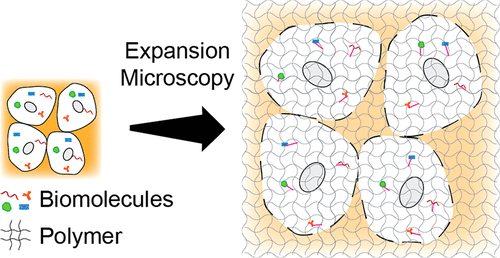Our official English website, www.x-mol.net, welcomes your feedback! (Note: you will need to create a separate account there.)
Expansion Microscopy: Toward Nanoscale Imaging of a Diverse Range of Biomolecules.
ACS Nano ( IF 17.1 ) Pub Date : 2020-07-06 , DOI: 10.1021/acsnano.0c04374 Aleksandra Klimas 1 , Yongxin Zhao 1
ACS Nano ( IF 17.1 ) Pub Date : 2020-07-06 , DOI: 10.1021/acsnano.0c04374 Aleksandra Klimas 1 , Yongxin Zhao 1
Affiliation

|
Expansion microscopy (ExM) has become a powerful imaging tool for visualizing the nanoscale organization of protein and nucleic acid targets in cells and tissues using only a conventional microscope. Until recently, current ExM approaches have had limited applicability to imaging other biomolecules, such as lipids and small molecules. With the new TRITON probes reported by Wen et al. in this issue of ACS Nano, ExM can now be used to perform nanoscale imaging of the cytoskeleton and lipid membranes. In this Perspective, we offer a brief overview of recent developments in ExM, with a focus on biomolecule anchoring and labeling strategies that target a wide range of biomolecules to the water-swellable polymer formed in situ, a key step that ensures biomolecules or labels of interest are separated in space and can be resolved on a conventional microscope. In addition to these new advancements, we discuss challenges and future directions in this exciting field.
中文翻译:

扩展显微镜:向生物分子的各种范围的纳米级成像。
扩展显微镜(ExM)已成为一种功能强大的成像工具,仅使用常规显微镜就可以可视化细胞和组织中蛋白质和核酸靶标的纳米级组织。直到最近,当前的ExM方法在成像其他生物分子(如脂质和小分子)方面的适用性仍然有限。Wen等人报道了新的TRITON探针。在本期ACS Nano中,ExM现在可用于执行细胞骨架和脂质膜的纳米级成像。在此观点中,我们简要概述了ExM的最新发展,重点是针对大分子生物分子的锚定和标记策略,这些生物分子针对就地形成的水溶胀性聚合物,这是确保目标生物分子或目标标记在空间上分离并可以在常规显微镜上解析的关键步骤。除了这些新的进步,我们还将讨论这一激动人心的领域中的挑战和未来方向。
更新日期:2020-07-28
中文翻译:

扩展显微镜:向生物分子的各种范围的纳米级成像。
扩展显微镜(ExM)已成为一种功能强大的成像工具,仅使用常规显微镜就可以可视化细胞和组织中蛋白质和核酸靶标的纳米级组织。直到最近,当前的ExM方法在成像其他生物分子(如脂质和小分子)方面的适用性仍然有限。Wen等人报道了新的TRITON探针。在本期ACS Nano中,ExM现在可用于执行细胞骨架和脂质膜的纳米级成像。在此观点中,我们简要概述了ExM的最新发展,重点是针对大分子生物分子的锚定和标记策略,这些生物分子针对就地形成的水溶胀性聚合物,这是确保目标生物分子或目标标记在空间上分离并可以在常规显微镜上解析的关键步骤。除了这些新的进步,我们还将讨论这一激动人心的领域中的挑战和未来方向。



























 京公网安备 11010802027423号
京公网安备 11010802027423号